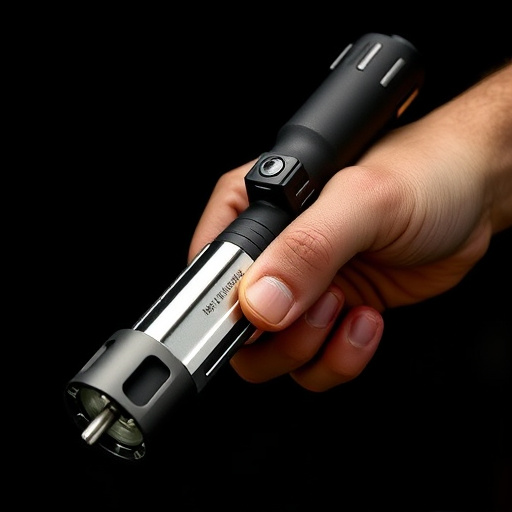In case of a malfunctioning self-defense expandable baton, conduct a visual inspection for damage or wear, check the locking mechanism and test manual extension/retraction for issues. Regular maintenance checks are crucial for optimal functionality and safety. Common causes of malfunction include internal mechanism damage, worn bearings, improper use, and manufacturing defects. Basic troubleshooting involves checking battery power, connections, threads, and disassembling for internal component inspection; lubricating spray may be helpful. Adhere to manufacturer guidelines for proper baton maintenance.
Are you tired of your self-defense expandable baton not performing as it should? Don’t worry, you’re not alone. Malfunctions can occur due to various reasons, but with the right troubleshooting steps, you can get your baton back in top shape. This comprehensive guide walks you through assessing the issue, performing basic and advanced repairs, and ensuring your baton is always ready when you need it most. Learn how to identify unusual behavior, troubleshoot common problems, and implement preventative maintenance tips for optimal performance of your self-defense expandable baton.
- Assessing the Malfunction
- – Recognizing unusual behavior in the self-defense expandable baton
- – Types of malfunctions and their potential causes
- Initial Troubleshooting Steps
Assessing the Malfunction
When dealing with a malfunctioning telescopic self-defense expandable baton, the first step is to assess the issue at hand. Start by examining the baton for any visible signs of damage or wear and tear. Check if there are any loose or missing parts, especially the locking mechanism, as this is crucial for the baton’s functionality. Ensure all components are securely in place.
Next, try extending and retracting the baton manually to identify where the problem lies. Is there resistance or a sudden stop during the extension process? These could be indications of issues with the internal springs or the telescoping mechanism. If the baton fails to extend fully, it might be due to a jam or a damaged spring. Understanding these initial symptoms will guide you in selecting the appropriate troubleshooting steps for your self-defense expandable baton.
– Recognizing unusual behavior in the self-defense expandable baton
Unusual behavior in a self-defense expandable baton, or telescopic baton, can be indicative of an underlying issue that requires immediate attention. Users should be vigilant for any sudden changes in the baton’s functionality during use. For instance, if the baton extends or retracts unexpectedly, becomes stuck at certain lengths, or fails to lock into place securely, these are clear signs of a potential malfunction. Such anomalies can occur due to various factors like damage to the internal components, wear and tear, or improper assembly.
Recognizing these unusual behaviors is crucial for users as it allows them to take prompt action. If any deviation from the baton’s usual performance is noticed, troubleshooting steps should be initiated immediately to prevent further complications. Regular maintenance checks can also help identify potential issues early on, ensuring optimal functionality and safety when relying on the self-defense expandable baton in emergency situations.
– Types of malfunctions and their potential causes
Telescopic batons, also known as self-defense expandable batons, are handy tools designed for personal safety. However, like any mechanical device, they can experience malfunctions. Understanding common issues and their causes is essential when troubleshooting. Malfunctions can range from a baton failing to extend or retract properly to locking in an extended position.
Potential causes include damage to the internal mechanisms, worn-out bearings, improper use (e.g., excessive force or incorrect storage), or defects in manufacturing. Regular maintenance, such as cleaning and lubrication, can help prevent many issues. Users should also handle batons with care, following the manufacturer’s guidelines for deployment and storage.
Initial Troubleshooting Steps
If your self-defense expandable baton isn’t extending or retracting properly, don’t panic! There are a few initial troubleshooting steps you can take to identify and resolve the issue quickly. Start by checking the battery power—a dead or weak battery can cause motor malfunction. Ensure the battery is fully charged and securely inserted into the baton’s compartment. Next, verify that all connections within the baton are tight and free from debris or damage. Check for any loose threads or frayed wires that could impede the smooth operation of the extension mechanism.
If the problem persists, try disassembling the baton (refer to the manufacturer’s instructions for safe disassembly) and inspecting each component carefully. Look for signs of wear or misalignment in the internal gears or springs. A lubricating spray can sometimes help resolve sticking or rough movement. Ensure you use a product recommended for precision tools to avoid causing further damage.
If you’ve encountered a malfunction with your self-defense expandable baton, don’t panic. By carefully assessing the issue using our provided guide and attempting initial troubleshooting steps, you can often resolve the problem swiftly. Remember, proper maintenance and understanding of your baton’s mechanics are key to ensuring its reliability when you need it most. With these steps as your foundation, you’re now equipped to navigate and overcome common telescopic baton malfunctions.
